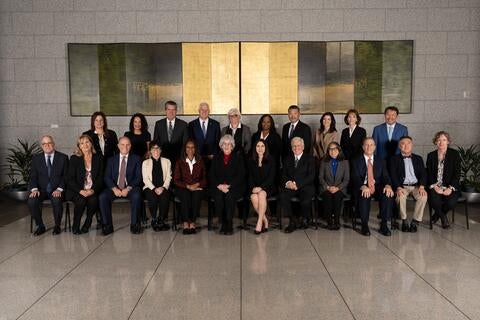Judicial Branch Governance | Judicial Council of California
- Created by constitutional amendment, the council is the policymaking body for California’s state court system
- The 21 voting members include the Chief Justice, 14 judicial officers, 4 attorneys, and 1 member from each house of the Legislature
- The council also has advisory members who include judicial officers and court executives or administrators
- The council carries out much of its work through the hundreds of volunteers on its committees and task forces
- Staff to the council serve the courts, justice partners, and the public with a variety of programs and services
Created in 1926 by constitutional amendment, and chaired by the Chief Justice, the Judicial Council of California is the policymaking body for California’s state court system.
The California Constitution directs the Judicial Council to provide policy guidelines to the courts, make recommendations annually to the Governor and Legislature, and adopt and revise California Rules of Court in the areas of court administration, practice, and procedure. The council performs its constitutional and other functions with the support of its staff.
Council Membership
New judicial members of the council and its committees, the majority of whom are publicly elected justices and judges, are selected through a nominating procedure intended to attract applicants from throughout the legal system and to result in a membership that is diverse in experience, gender, ethnic background, and geography.
The 21 voting members of the Judicial Council―as established in the California Constitution―consist of the Chief Justice, 14 judicial officers appointed by the Chief Justice, 4 attorney members appointed by the State Bar Board of Trustees, and 1 member from each house of the Legislature. Council members do not represent any particular constituency but act in the best interests of the statewide judicial system and the public.
The council also has approximately 10 advisory members who include court executives or administrators, the chair of the council’s Trial Court Presiding Judges Advisory Committee, and the president of the California Judges Association. Staggered terms, with roughly one-third of the council’s membership changing yearly, ensure continuity while creating opportunities for new participation and input. The council performs most of its work through internal committees and advisory committees and task forces.
Council Advisory Committees
The Judicial Council carries out much of its work through internal committees, advisory committees, and task forces. About one-third of the judicial branch’s judges and justices participate on advisory committees or task forces. Every superior and appellate court is represented on at least one advisory body.
While the majority of committee members are justices, judges, and court personnel, the advisory bodies include a broad range of members to ensure the council hears from many voices from within and outside of the judicial system. Other members include attorneys, interpreters, professors, child advocates, educators, probation officers, business executives, and representatives from tribal courts, law enforcement, legal services, public libraries, and other judicial branch stakeholders.
Council Staff
The Judicial Council’s staff serves the courts, justice partners, and the public, improving access to justice with various programs and services. In addition to directly supporting the council’s advisory bodies, council staff provide services to the courts in the areas of budgeting, accounting, human resources, education, court construction, real estate management, security consulting, information technology, research, communications, criminal justice, family and juvenile law, and more. The Administrative Director is accountable to the Judicial Council and to the Chief Justice for the performance of council staff. The Administrative Director serves as the Judicial Council Secretary and is charged with accomplishing the council's goals and priorities.


